Life Cycle Assessment of a Thermal Recycling Process as an Alternative to Existing CFRP and GFRP Composite Wastes Management Options
Abstract
:1. Introduction
1.1. Background
1.2. Literature Review
2. Methodology
2.1. Studied Waste
2.2. Thermal Recycling Route
2.3. Life Cycle Assessment
2.3.1. Goal and Scope Definition
2.3.2. Life Cycle Inventory
2.3.3. Sensitivity Analysis
3. Results
3.1. Impacts from Recycled Composite Production
3.1.1. rCFRP Production
3.1.2. rGFRP Production
3.2. Environmental Impacts: Gate-to-Grave
3.2.1. CFRP Waste Disposal Methods
3.2.2. GFRP Waste Disposal Methods
4. Discussion
5. Conclusions
Author Contributions
Funding
Data Availability Statement
Conflicts of Interest
References
- Karuppannan Gopalraj, S.; Kärki, T. A review on the recycling of waste carbon fibre/glass fibre-reinforced composites: Fibre recovery, properties and life-cycle analysis. SN Appl. Sci. 2020, 2, 433. [Google Scholar] [CrossRef] [Green Version]
- Global Composites Market Size|Industry Report, 2020–2027. Available online: https://www.grandviewresearch.com/industry-analysis/composites-market (accessed on 2 October 2021).
- Global Wind Energy Council. Global Wind Report 2021; Global Wind Energy Council: Brussels, Belgium, 2021; Available online: https://gwec.net/global-wind-report-2021/ (accessed on 6 September 2021).
- Lefeuvre, A.; Garnier, S.; Jacquemin, L.; Pillain, B.; Sonnemann, G. Anticipating in-use stocks of carbon fibre reinforced polymers and related waste generated by the wind power sector until 2050. Resour. Conserv. Recycl. 2019, 141, 30–39. [Google Scholar] [CrossRef]
- Das, S. Life cycle assessment of carbon fiber-reinforced polymer composites. Int. J. Life Cycle Assess. 2011, 16, 268–282. [Google Scholar] [CrossRef]
- Hermansson, F.; Janssen, M.; Svanström, M. Prospective study of lignin-based and recycled carbon fibers in composites through meta-analysis of life cycle assessments. J. Clean. Prod. 2019, 223, 946–956. [Google Scholar] [CrossRef]
- Meng, F.; McKechnie, J.; Turner, T.; Wong, K.H.; Pickering, S.J. Environmental Aspects of Use of Recycled Carbon Fiber Composites in Automotive Applications. Environ. Sci. Technol. 2017, 51, 12727–12736. [Google Scholar] [CrossRef]
- Song, Y.S.; Youn, J.R.; Gutowski, T.G. Life cycle energy analysis of fiber-reinforced composites. Compos. Part A Appl. Sci. Manuf. 2009, 40, 1257–1265. [Google Scholar] [CrossRef]
- End of Life Options|Composites UK. Available online: https://compositesuk.co.uk/composite-materials/properties/end-life-options (accessed on 6 October 2021).
- European Parliament and Council. Directive 2008/98/EC of the European Parliament and of the Council of 19 November 2008 on Waste and Repealing Certain Directives; European Parliament and Council: Brussels, Belgium, 2008. [Google Scholar]
- Witik, R.A.; Teuscher, R.; Michaud, V.; Ludwig, C.; Månson, J.-A.E. Carbon fibre reinforced composite waste: An environmental assessment of recycling, energy recovery and landfilling. Compos. Part A Appl. Sci. Manuf. 2013, 49, 89–99. [Google Scholar] [CrossRef]
- La Rosa, A.D.; Banatao, D.R.; Pastine, S.J.; Latteri, A.; Cicala, G. Recycling treatment of carbon fibre/epoxy composites: Materials recovery and characterization and environmental impacts through life cycle assessment. Compos. Part B Eng. 2016, 104, 17–25. [Google Scholar] [CrossRef]
- Li, X.; Bai, R.; McKechnie, J. Environmental and financial performance of mechanical recycling of carbon fibre reinforced polymers and comparison with conventional disposal routes. J. Clean. Prod. 2016, 127, 451–460. [Google Scholar] [CrossRef]
- Meng, F.; McKechnie, J.; Turner, T.A.; Pickering, S.J. Energy and environmental assessment and reuse of fluidised bed recycled carbon fibres. Compos. Part A Appl. Sci. Manuf. 2017, 100, 206–214. [Google Scholar] [CrossRef]
- Meng, F.; Olivetti, E.A.; Zhao, Y.; Chang, J.C.; Pickering, S.J.; McKechnie, J. Comparing Life Cycle Energy and Global Warming Potential of Carbon Fiber Composite Recycling Technologies and Waste Management Options. ACS Sustain. Chem. Eng. 2018, 6, 9854–9865. [Google Scholar] [CrossRef]
- Meng, F.; McKechnie, J.; Pickering, S.J. An assessment of financial viability of recycled carbon fibre in automotive applications. Compos. Part A Appl. Sci. Manuf. 2018, 109, 207–220. [Google Scholar] [CrossRef] [Green Version]
- Vo Dong, P.A.; Azzaro-Pantel, C.; Cadene, A.-L. Economic and environmental assessment of recovery and disposal pathways for CFRP waste management. Resour. Conserv. Recycl. 2018, 133, 63–75. [Google Scholar] [CrossRef] [Green Version]
- Khalil, Y.F. Comparative environmental and human health evaluations of thermolysis and solvolysis recycling technologies of carbon fiber reinforced polymer waste. Waste Manag. 2018, 76, 767–778. [Google Scholar] [CrossRef]
- Pillain, B.; Loubet, P.; Pestalozzi, F.; Woidasky, J.; Erriguible, A.; Aymonier, C.; Sonnemann, G. Positioning supercritical solvolysis among innovative recycling and current waste management scenarios for carbon fiber reinforced plastics thanks to comparative life cycle assessment. J. Supercrit. Fluids 2019, 154, 104607. [Google Scholar] [CrossRef]
- Liu, P.; Meng, F.; Barlow, C.Y. Wind turbine blade end-of-life options: An eco-audit comparison. J. Clean. Prod. 2019, 212, 1268–1281. [Google Scholar] [CrossRef] [Green Version]
- Meng, F.; Cui, Y.; Pickering, S.; McKechnie, J. From aviation to aviation: Environmental and financial viability of closed-loop recycling of carbon fibre composite. Compos. Part B Eng. 2020, 200, 108362. [Google Scholar] [CrossRef]
- Tapper, R.J.; Longana, M.L.; Norton, A.; Potter, K.D.; Hamerton, I. An evaluation of life cycle assessment and its application to the closed-loop recycling of carbon fibre reinforced polymers. Compos. Part B Eng. 2020, 184, 107665. [Google Scholar] [CrossRef]
- La Rosa, A.D.; Greco, S.; Tosto, C.; Cicala, G. LCA and LCC of a chemical recycling process of waste CF-thermoset composites for the production of novel CF-thermoplastic composites. Open loop and closed loop scenarios. J. Clean. Prod. 2021, 304, 127158. [Google Scholar] [CrossRef]
- Karuppannan Gopalraj, S.; Kärki, T. A Study to Investigate the Mechanical Properties of Recycled Carbon Fibre/Glass Fibre-Reinforced Epoxy Composites Using a Novel Thermal Recycling Process. Processes 2020, 8, 954. [Google Scholar] [CrossRef]
- Karuppannan Gopalraj, S.; Kärki, T. A Finite Element Study to Investigate the Mechanical Behaviour of Unidirectional Recycled Carbon Fibre/Glass Fibre–Reinforced Epoxy Composites. Polymers 2021, 13, 3192. [Google Scholar] [CrossRef] [PubMed]
- SFS-EN ISO 14040. Environmental Management-Life Cycle Assessment-Principles and Framework (ISO 14040:2006); International Organization for Standardization: Geneva, Switzerland, 2006. [Google Scholar]
- SFS-EN ISO 14044. Environmental Management–Life Cycle Assessment–Requirements and Guidelines (ISO 14044:2006); International Organization for Standardization: Geneva, Switzerland, 2006. [Google Scholar]
- Thinkstep AG. GaBi Software System and Database for Life Cycle Engineering. Available online: https://thinkstep.com/software/gabi-software/gabi-professional (accessed on 8 August 2021).
- Pillain, B.; Gemechu, E.; Sonnemann, G. Identification of Key Sustainability Performance Indicators and related assessment methods for the carbon fiber recycling sector. Ecol. Indic. 2017, 72, 833–847. [Google Scholar] [CrossRef]
- Sphera Environmental Footprint (EF)/ILCD Recommendation. Available online: https://gabi.sphera.com/solutions/environmental-footprint/ (accessed on 8 August 2021).
- Scheepens, A.; van der Flier, A.; Romeo-Hall, A.; Veugen, R. EuCIA Eco Impact Calculator. Background Report. Version 1.4. Brussels, Belgium, 2020. Available online: https://ecocalculator.eucia.eu/Account/TermsAndConditions (accessed on 8 October 2021).
- Vita, A.; Castorani, V.; Germani, M.; Marconi, M. Comparative life cycle assessment of low-pressure RTM, compression RTM and high-pressure RTM manufacturing processes to produce CFRP car hoods. Procedia CIRP 2019, 80, 352–357. [Google Scholar] [CrossRef]
- Khan, M.M.H.; Havukainen, J.; Horttanainen, M. Impact of utilizing solid recovered fuel on the global warming potential of cement production and waste management system: A life cycle assessment approach. Waste Manag. Res. 2020, 39, 561–572. [Google Scholar] [CrossRef]
- Petrakli, F.; Gkika, A.; Bonou, A.; Karayannis, P.; Koumoulos, E.P.; Semitekolos, D.; Trompeta, A.-F.; Rocha, N.; Santos, R.M.; Simmonds, G.; et al. End-of-Life Recycling Options of (Nano)Enhanced CFRP Composite Prototypes Waste—A Life Cycle Perspective. Polymers 2020, 12, 2129. [Google Scholar] [CrossRef]
- Ribeiro, M.; Fiúza, A.; Ferreira, A.; Dinis, M.; Meira Castro, A.; Meixedo, J.; Alvim, M. Recycling Approach towards Sustainability Advance of Composite Materials’ Industry. Recycling 2016, 1, 178–193. [Google Scholar] [CrossRef] [Green Version]
- Pickering, S.J. Recycling technologies for thermoset composite materials—Current status. Compos. Part A Appl. Sci. Manuf. 2006, 37, 1206–1215. [Google Scholar] [CrossRef]
- Liu, W.; Huang, H.; Liu, Y.; Li, L.; Cheng, H.; Liu, Z. Life cycle assessment and energy intensity of CFRP recycling using supercritical N-butanol. J. Mater. Cycles Waste Manag. 2021, 23, 1303–1319. [Google Scholar] [CrossRef]
- Nunes, A.O.; Viana, L.R.; Guineheuc, P.-M.; da Silva Moris, V.A.; de Paiva, J.M.F.; Barna, R.; Soudais, Y. Life cycle assessment of a steam thermolysis process to recover carbon fibers from carbon fiber-reinforced polymer waste. Int. J. Life Cycle Assess. 2018, 23, 1825–1838. [Google Scholar] [CrossRef] [Green Version]
- He, D.; Soo, V.K.; Kim, H.C.; Compston, P.; Doolan, M. Comparative life cycle energy analysis of carbon fibre pre-processing, processing and post-processing recycling methods. Resour. Conserv. Recycl. 2020, 158, 104794. [Google Scholar] [CrossRef]
- Oliveux, G.; Dandy, L.O.; Leeke, G.A. Current status of recycling of fibre reinforced polymers: Review of technologies, reuse and resulting properties. Prog. Mater. Sci. 2015, 72, 61–99. [Google Scholar] [CrossRef] [Green Version]
- Pimenta, S.; Pinho, S.T. Recycling carbon fibre reinforced polymers for structural applications: Technology review and market outlook. Waste Manag. 2011, 31, 378–392. [Google Scholar] [CrossRef] [PubMed] [Green Version]

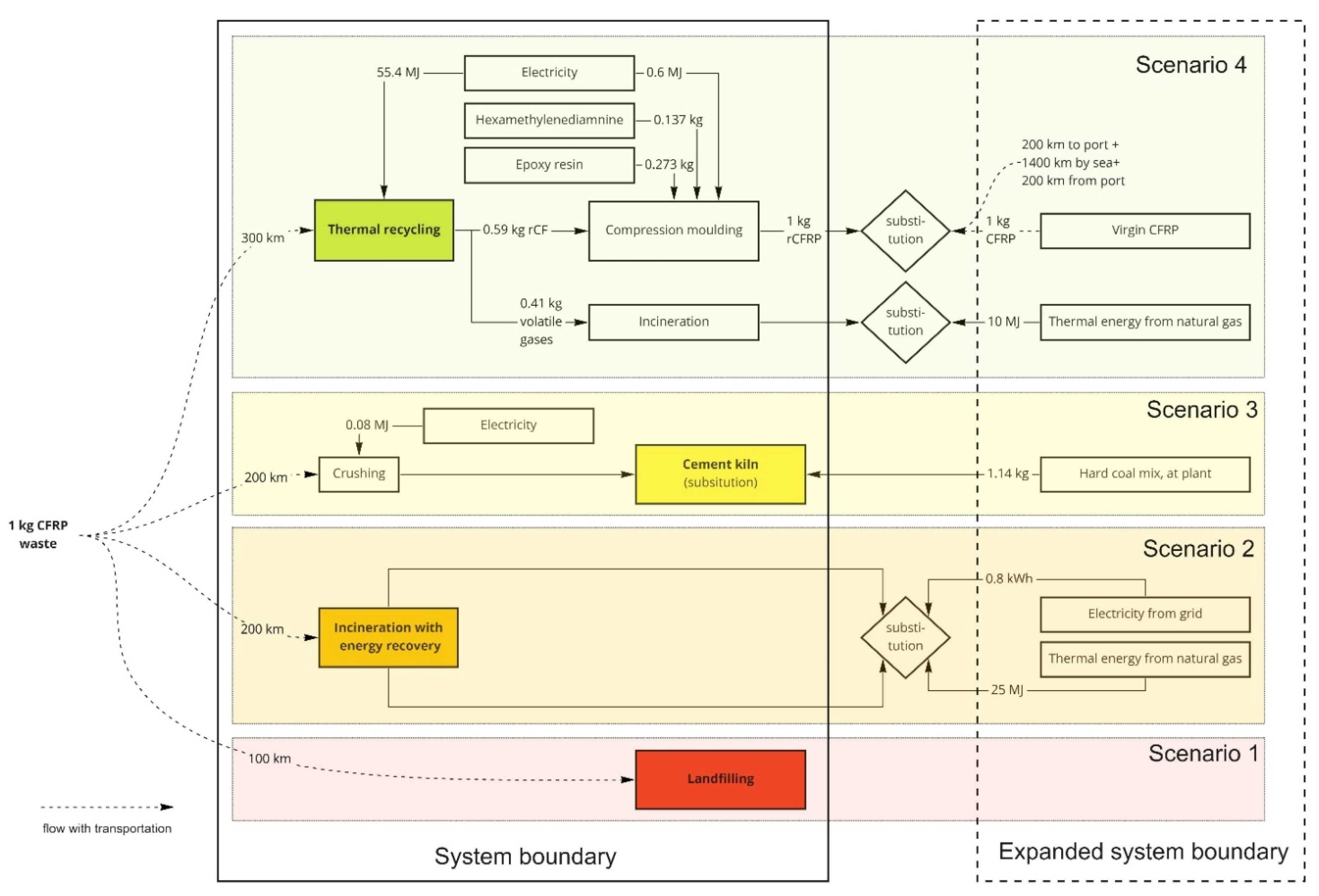
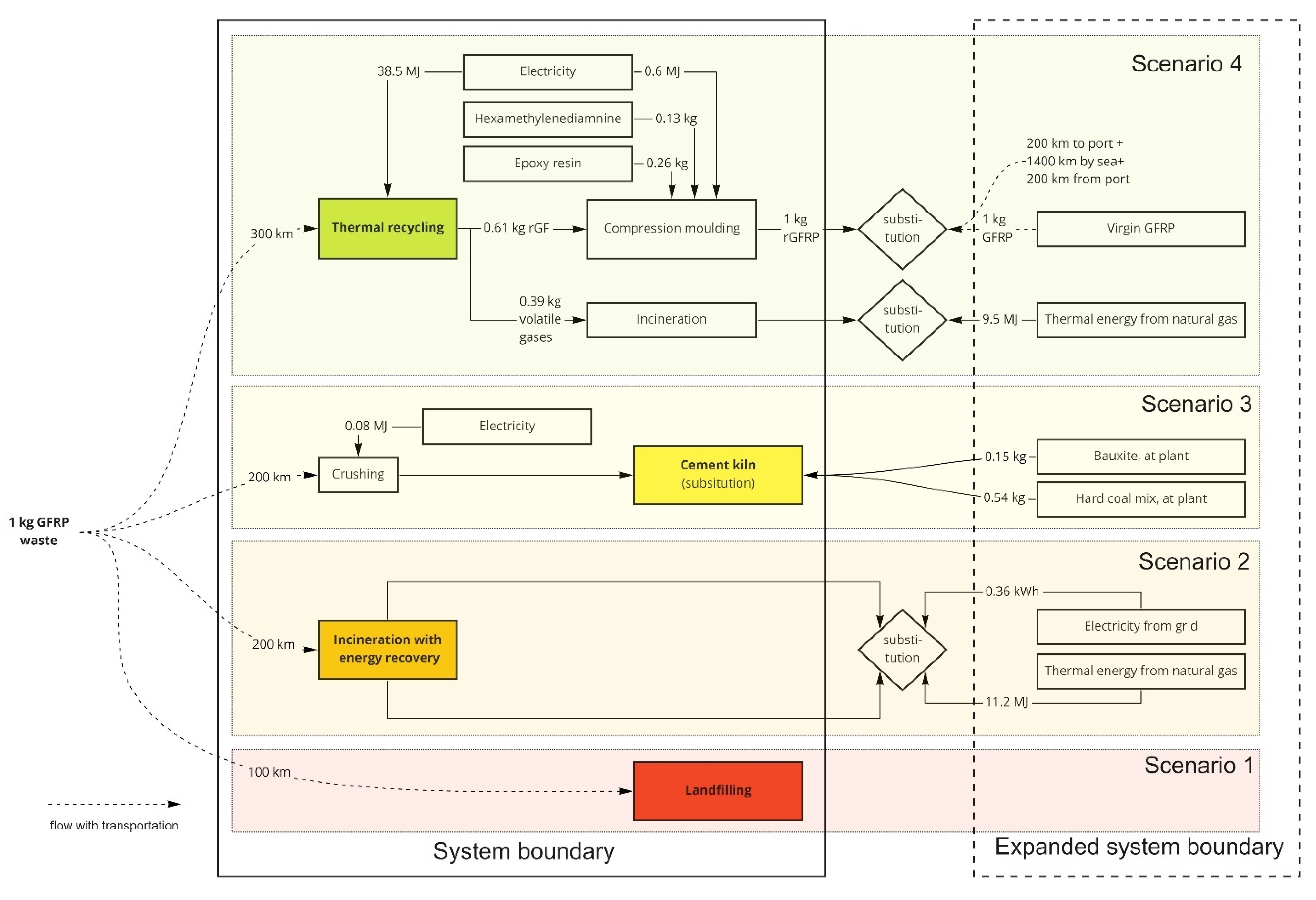
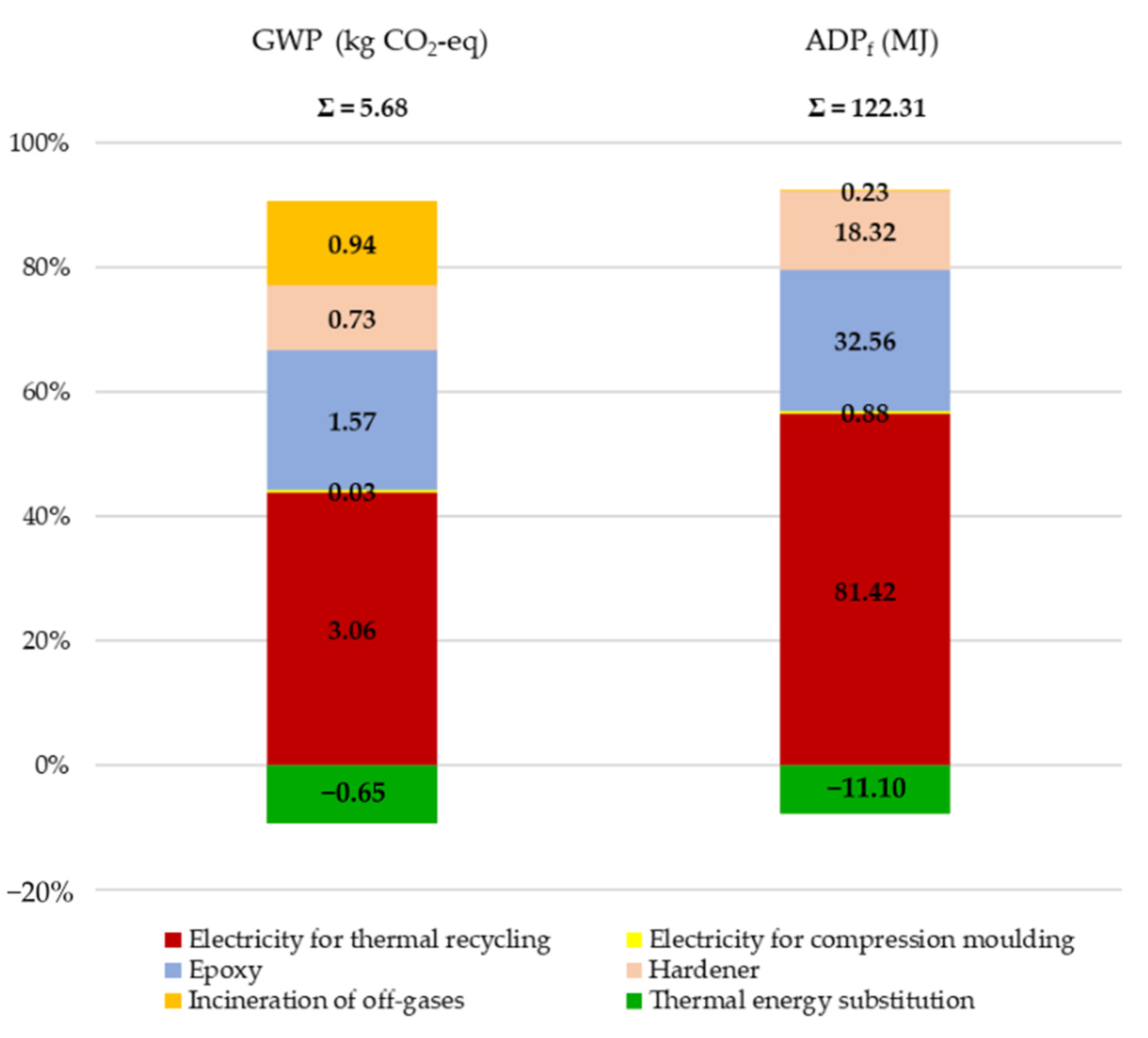
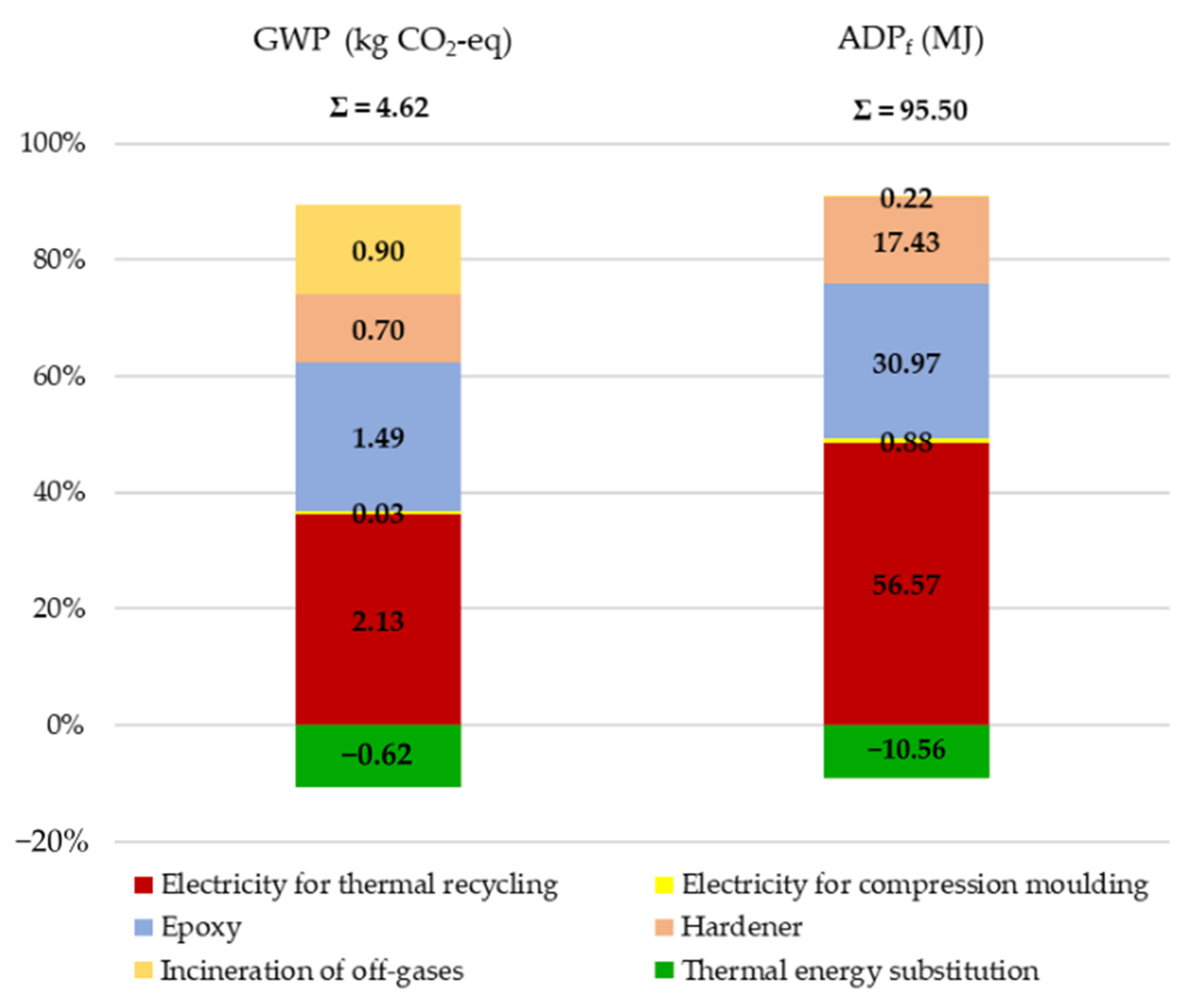
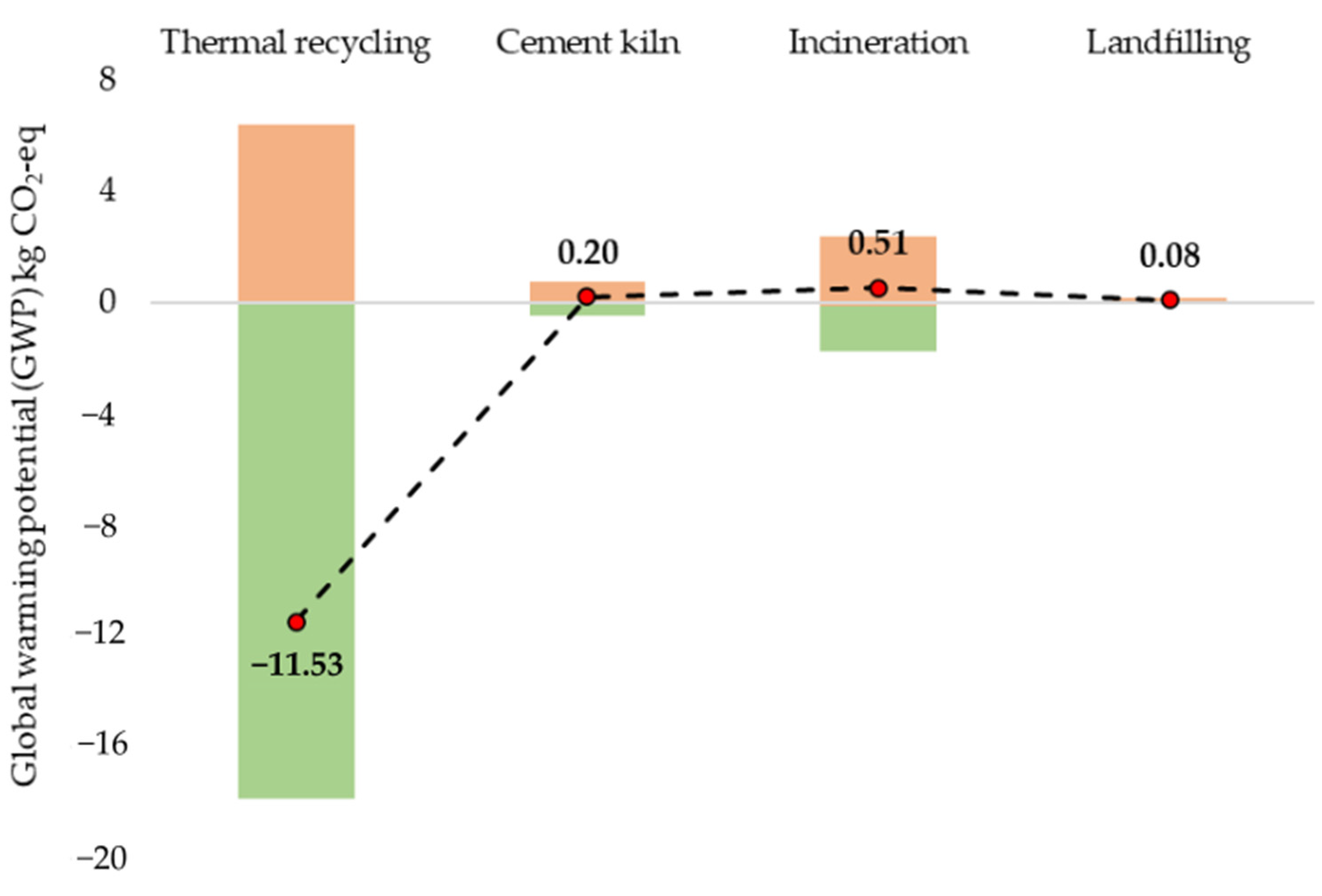
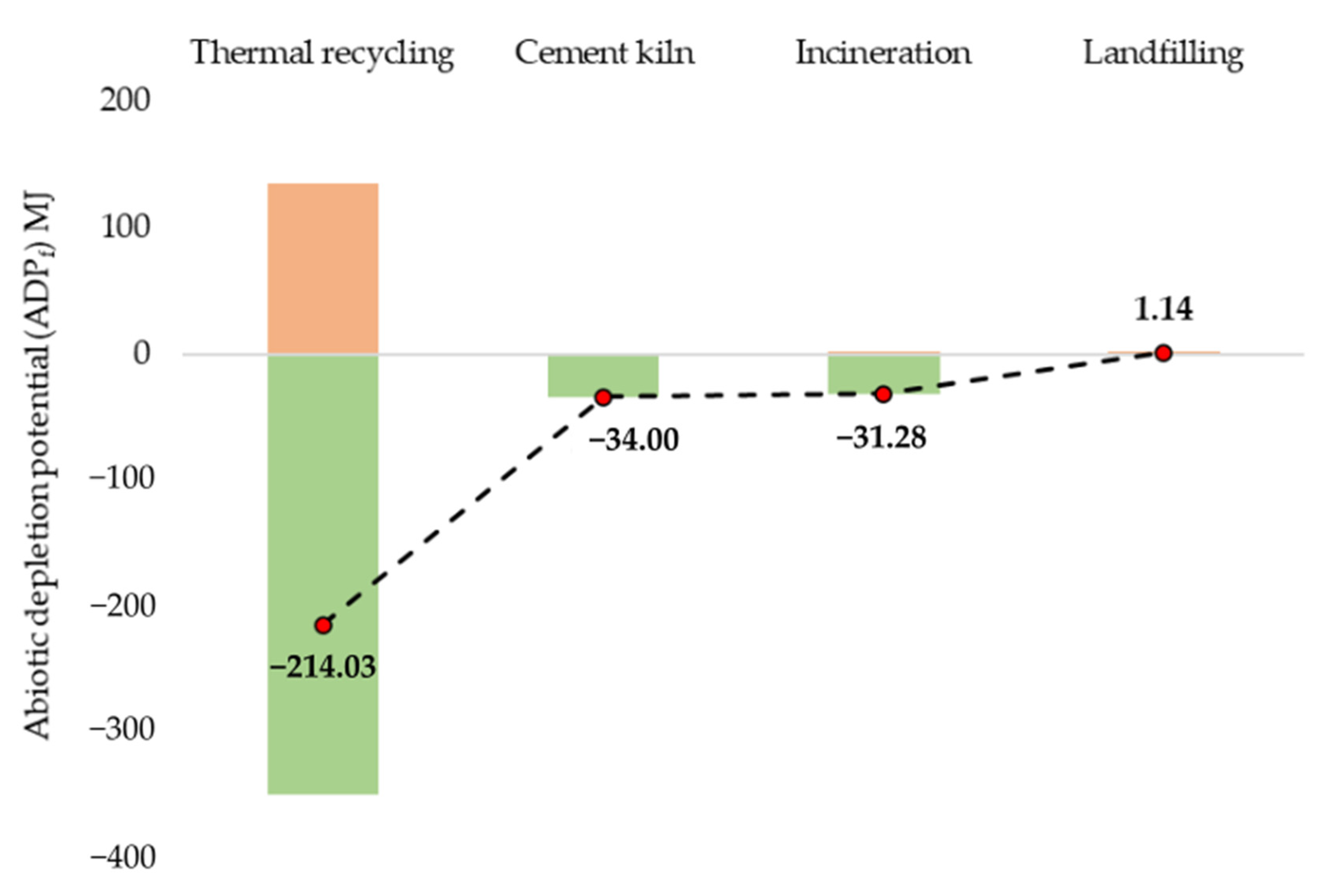


| Composite Recipes | Vf (wt%) | Vr (wt%) | Tensile Strength (MPa) | Young Modulus (GPa) | Impact Strength (kJ/m2) | Fracture Strain (No Unit) | Density (g/cm3) | Poisson Ratio |
|---|---|---|---|---|---|---|---|---|
| rCFRP | 60 ± 2 | 40 ± 2 | 235.70 | 60.80 | 53.61 | 0.00683 | 1.52 | 1.52 |
| 40 ± 2 | 60 ± 2 | 210.34 | 45.28 | 49.98 | 0.00827 | 1.64 | 1.64 | |
| rGFRP | 60 ± 2 | 40 ± 2 | 114.58 | 30.72 | 41.05 | 0.00272 | 1.77 | 1.77 |
| 40 ± 2 | 60 ± 2 | 65.42 | 27.37 | 18.99 | 0.00156 | 1.85 | 1.85 |
| Amount | Unit | Unit Process | |
|---|---|---|---|
| Inputs | |||
| Amonium bicarbonate | 0.02 | kg | RER: market for ammonium bicarbonate ecoinvent 3.6 |
| Epoxy resin | 0.01 | kg | DE: Epoxy resin (EP) mix |
| Polyacrylonitrile fibres | 1.89 | kg | EU-28: Polyacrylonitrile Fibres (PAN) |
| Polydimethylsolixane | 0.01 | kg | GLO: market for polydimethylsiloxane ecoinvent 3.6 |
| Potassium permanganate | 0.1 | kg | GLO: market for potassium permanganate ecoinvent 3.6 |
| Sulphuric acid | 0.02 | kg | EU-28: Sulphuric acid (96%) |
| Water | 2.77 | l | EU-28: Process water from surface water |
| Electricity | 20.2 | kWh | EU-28: Electricity from grid mix |
| Heat | 98.4 | MJ | EU-28: Thermal energy from natural gas |
| Outputs | |||
| Carbon fibres | 1 | kg | - |
| Carbon dioxide | 0.63 | kg | - |
| Nitrogen monoxide | 0.33 | kg | - |
| Nitrogen dioxide | 0.66 | kg | - |
| Flow | from | to | Distance | Transportation Mode |
|---|---|---|---|---|
| CFRP waste/GFRP waste | Generation place | Recycling facility | 300 km | Truck 1 |
| Cement kiln | 200 km | Truck 1 | ||
| Incineration plant | 200 km | Truck 1 | ||
| Landfill | 100 km | Truck 1 | ||
| rCFRP/rGFRP | Recycling facility | Customer | 100 km | Truck 1 |
| vCFRP/vGFRP | Production | Port in Germany | 200 km | Truck 1 |
| Port in Germany | Port in Finland | 1400 km | Sea-going container ship 2 | |
| Port in Finland | Consumer | 200 km | Truck 1 |
Publisher’s Note: MDPI stays neutral with regard to jurisdictional claims in published maps and institutional affiliations. |
© 2021 by the authors. Licensee MDPI, Basel, Switzerland. This article is an open access article distributed under the terms and conditions of the Creative Commons Attribution (CC BY) license (https://creativecommons.org/licenses/by/4.0/).
Share and Cite
Karuppannan Gopalraj, S.; Deviatkin, I.; Horttanainen, M.; Kärki, T. Life Cycle Assessment of a Thermal Recycling Process as an Alternative to Existing CFRP and GFRP Composite Wastes Management Options. Polymers 2021, 13, 4430. https://doi.org/10.3390/polym13244430
Karuppannan Gopalraj S, Deviatkin I, Horttanainen M, Kärki T. Life Cycle Assessment of a Thermal Recycling Process as an Alternative to Existing CFRP and GFRP Composite Wastes Management Options. Polymers. 2021; 13(24):4430. https://doi.org/10.3390/polym13244430
Chicago/Turabian StyleKaruppannan Gopalraj, Sankar, Ivan Deviatkin, Mika Horttanainen, and Timo Kärki. 2021. "Life Cycle Assessment of a Thermal Recycling Process as an Alternative to Existing CFRP and GFRP Composite Wastes Management Options" Polymers 13, no. 24: 4430. https://doi.org/10.3390/polym13244430








